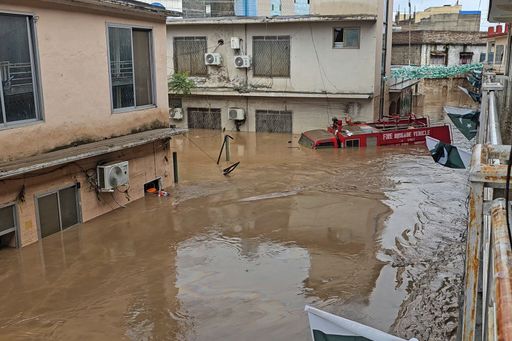Rescuers were struggling to retrieve bodies from debris after flash floods triggered by heavy monsoon rains across northern Pakistan killed at least 344 people in the past 48 hours, authorities said on Saturday.
The majority of deaths, 328, were reported in mountainous Khyber Pakhtunkhwa province, the Provincial Disaster Management Authority said.
Most were killed in flash floods and collapsing houses, while at least 120 others were injured.
One resident told AFP it felt like "the end of the world" was coming, as the ground shook with the force of the water.
The provincial rescue agency told AFP that around 2,000 rescue workers were engaged in recovering bodies from the debris and carrying out relief operations in nine affected districts where rain was still hampering efforts.
"Heavy rainfall, landslides in several areas, and washed-out roads are causing significant challenges in delivering aid, particularly in transporting heavy machinery and ambulances," said Bilal Ahmed Faizi, spokesman for Khyber Pakhtunkhwa's rescue agency.
"Due to road closures in most areas, rescue workers are travelling on foot to conduct operations in remote regions," he told AFP.
"They are trying to evacuate survivors, but very few people are relocating due to the deaths of their relatives or loved ones being trapped in the debris."
The provincial government has declared the severely affected mountainous districts of Buner, Bajaur, Swat, Shangla, Mansehra and Battagram as disaster-hit areas.
The meteorological department has issued a heavy rain alert for Pakistan's northwest, urging people to take "precautionary measures".
Eleven more people were killed in Pakistan-administered Kashmir, while five died in the northern Gilgit-Baltistan region, the national disaster authority said.
Another five people, including two pilots, were killed when a local government helicopter crashed due to bad weather during a relief mission on Friday.

'Reeling from profound trauma'
The monsoon season brings South Asia about three-quarters of its annual rainfall, vital for agriculture and food security, but it also brings destruction.
Landslides and flash floods are common during the season, which usually begins in June and eases by the end of September.
Syed Muhammad Tayyab Shah, a representative of the national disaster agency, told AFP that this year's monsoon season began earlier than usual and was expected to end later.
"The next 15 days... the intensity of the monsoon will further exacerbate," he said.
In Buner district, where there have been dozens of deaths and injuries, resident Azizullah said he "thought it was doomsday".
"I heard a loud noise as if the mountain was sliding. I rushed outside and saw the entire area shaking, like it was the end of the world," he told AFP.
"The ground was trembling due to the force of the water, and it felt like death was staring me in the face."
In Bajaur, a tribal district abutting Afghanistan, a crowd gathered around an excavator digging through a mud-soaked hill.
On Friday, funeral prayers began in a paddock nearby, with people grieving in front of several bodies covered by blankets.
In the picturesque district of Swat, an AFP photographer saw roads submerged in muddy water, electricity poles grounded, and vehicles half-buried in mud.
The torrential rains that have pounded Pakistan since the start of the summer monsoon, described as "unusual" by authorities, have killed more than 650 people, with more than 880 injured.
In July, Punjab, home to nearly half of Pakistan's 255 million people, recorded 73 percent more rainfall than the previous year and more deaths than in the entire previous monsoon.
Pakistan is one of the world's most vulnerable countries to the effects of climate crisis, and its population is contending with extreme weather events with increasing frequency.



















